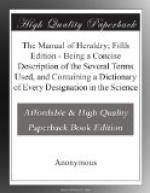In after times, on the creation of a peer, the Heralds selected the supporters they deemed most appropriate, having some allusion either to the deeds, name, title, arms, or motto of the newly-created peer.
SURMOUNTED. A figure or bearing having another over it.
[Illustration: Surmounted]
Ex. Gules, a sword erect in pale, argent, surmounted by two keys, saltier, or.
SURTOUT. The French word for “over all.” See ESCUTCHEON OF PRETENCE and OVER ALL.
TALBOT. A dog formerly used for hunting. It is formed something between a hound and a beagle, with a large snout, and long, round, thick ears.
[Illustration: Talbot]
Ex. Argent, a talbot’s head erased, seme of billets.
TENNE, or TAWNEY. One of the tinctures used in emblazoning arms. It signifies orange colour, and is represented in engraving by lines drawn diagonally from the sinister to the dexter side of the shield, traversed by perpendicular lines from the base to the chief.
[Illustration: Tiara]
TIARA. The Pope’s mitre, with its triple crowns.
TINCTURE. A term used in Heraldry to express colour.
TOPAZ. The name of a precious stone, formerly used instead of or, in emblazoning the arms of the English nobility.
TORTEAUX. Red roundlets.
[Illustration: Torteaux]
Ex. Argent, three torteaux in bend, sinister.
TOURNAMENTS were combats of honour, in which persons of noble birth entered the lists to gain reputation in feats of arms. The name is derived from tourner, to turn, from the horsemen turning frequently as they rode round the enclosure, and during the course of the engagement. The design of tournaments was to train the nobility to the use of arms; none, therefore, were admitted to these sports but persons of noble birth, who could prove their descent, at least, by three generations. They were also required to be men of unspotted honour and integrity.
It was customary for princes, on some public festivity or rejoicing, to appoint a day for these entertainments, and give public notice to the knights in their own territories, as well as in the neighbouring states.
The knights generally made their appearance four days before the combat. They endeavoured to excel each other in the splendour of their equipage and dress, and in the excellence and beauty of their horses, which were adorned with the most costly caparisons. Their armorial ensigns were displayed with great pomp during three days, that all who viewed them might judge if they were worthy of entering the lists. The field where the tournament was to be held was railed in with pales. This place was called the lists. A king was appointed to preside over the sports, as were also judges to examine the knights’ armour and arms, and to see that no unfair advantage was taken. A number of other officers were appointed, which our space will not allow us to mention.




